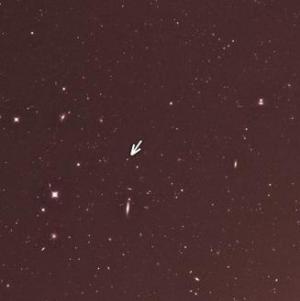The sun is an ordinary member in the disk of the Milky Way galaxy. Viewed from our planet, the galaxy's disk of the Milky Way's glittering sky - is the thin light belt that envelops the sky. The Milky Way can be observed more clearly on summer nights and winters are not from dark places.
The halo of our galaxy contains the oldest stars in the system. These stars are characterized by significantly less metal than the sun (astronomers say, metals are elements heavier than hydrogen and helium); therefore they also have less metal than most stars in the galaxy disk. The stars in this halo are the second generation of stars formed in our universe, so they are witnesses from over 10 billion years ago, long before our solar system was shaped. city. Although our planet is in the galaxy's disk, stars in the halo (often with high velocity) are horizontally across the disk, in which a certain number of stars can be found in the neighborhood. close to us.
Most stars in the halo were previously known to be members of star clusters called spherical clusters. Recently, however, large-scale surveys have improved our understanding of older stars outside those clusters. The stars in the halo have a mass of 10 times or just a few tenths of the mass of our sun, which suggests that the product of star formation is 10 billion years ago in essence. different from the product of the ongoing star formation process in the galaxy. What about the coldest and lightest stars? These are the stars that lie on the boundary that classify them as brown dwarfs. Could it be that the pillars were born into brown dwarfs, or "failed", from these 10 billion years when it was only one-fifth the age of now?
 The oldest known brown dwarf in the galaxy (marked with an arrow) appears in an infrared image taken with an Omega 2000 camera mounted on a 3.5-meter Calar Alto telescope (Photo: Image courtesy of Calar Alto Observatory-CAHA)
The oldest known brown dwarf in the galaxy (marked with an arrow) appears in an infrared image taken with an Omega 2000 camera mounted on a 3.5-meter Calar Alto telescope (Photo: Image courtesy of Calar Alto Observatory-CAHA)
It is not easy to spot small stars or brown dwarfs from the first time because they are extremely dim under optical wavelengths. They can only be observed with infrared light. Today we know that hundreds of young brown dwarfs live in galaxies, all of them discovered in the past decade. But only some 'candidates' belong to the oldest population in the halo. How to confirm whether these candidates are really near-star objects in the halo?
Elena Schilbach and Siegfried Roeser of the Center for Astronomy, University of Heidelberg with the Ralf-Dieter Scholz of the Potsdam Institute of Astrophysics observed the candidates in the Omega 2000 infrared camera mounted on a telescope. 3.5m glasses of Calar Alto Observatory, Spain. The objective of the observation is to determine the exact distance of these stars from our sun. The exact distance has an essential role in determining the absolute output energy of stars.
In order to determine the distance, candidates must be observed regularly for several years. This method is called the trigonometric parallax measurement. Our Earth moves around the sun. This causes a small change in perspective from which we observe the sky from our planet. For this reason, all stars seem to follow an elliptical path in the sky each year similar to galaxies located far away in the universe.
It seems that simplicity is quite challenging in reality. The farther the star is, the smaller the ellipse. Even the nearest star moves in an ellipse with a large axis of less than an arc-second, equivalent to 1/1800 of the full moon's moon diameter. In order to know the nature of the candidates, Elena Schilbach and his colleagues must measure with an accuracy of about 1000 times or more - this is equivalent to the size of a man looking from the earth. .
With the support of the Calar Alto observatory team, each objective was observed an average of 20 times throughout the 3 and a half years. Complex miniature data eventually yielded clear results. According to the authors, 'based on trigonometric parallax and absolute brightness of stars, both the poor metal star and the small mass stars are observed'. Six of the 10 targets have low metal properties, they contain only 1/30 of the metal compared to our sun, the remaining 4 stars have a ratio of about 1/3. Astronomers have also observed absolute output energy along with the colors of the targets consistent with hypothetical predictions for poor metal objects. In addition, one target among the poorest metal candidates, the 2MASS 1626 + 3925 object is too low in brightness, so it is forced to become a brown dwarf - and the oldest brown dwarf discovered in our galaxy until this point.
 Van Allen's belt and evidence that the Apollo 11 mission to the Moon was myth
Van Allen's belt and evidence that the Apollo 11 mission to the Moon was myth The levels of civilization in the universe (Kardashev scale)
The levels of civilization in the universe (Kardashev scale) Today Mars, the sun and the Earth are aligned
Today Mars, the sun and the Earth are aligned The Amazon owner announced a secret plan to build a space base for thousands of people
The Amazon owner announced a secret plan to build a space base for thousands of people